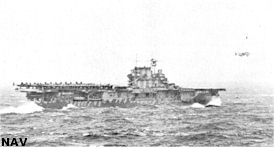
April 18, 1942: One of Doolittle's Raiders pulls away from Hornet CV-8. Note the remaining B-25 bombers spotted on the flight deck aft.
History:
Prewar -
1941 -
1942 -
1943 -
1944 -
1945 -
Postwar
The Ship -
All Hands -
Decorations -
Remembrance
 April 18, 1942: One of Doolittle's Raiders pulls away from Hornet CV-8. Note the remaining B-25 bombers spotted on the flight deck aft. |
Until a few years ago, one of the most famous yet least officially recognized feats of daring of the Pacific War was the Doolittle Raid of April 1942. On April 18, 1942, sixteen Army Air Force B-25 medium bombers under the command of Colonel James "Jimmy" Doolittle, streaked in low over Tokyo, Osaka, Kobe and other cities on the Japanese home islands, and dropped some 16 tons of bombs on a variety of military and industrial targets. While the bombing itself was too small to have any lasting military impact, its moral and psychological impact was tremendous, on both sides of the ocean. Americans, angry and down after four months of defeat - culminating in the fall of Bataan on April 8 - thrilled at word that finally the Japanese had been hit where they lived. And the Japanese leadership, alarmed by the vulnerability of the home islands, and the threat to the Emperor, embarked on strategic course which would culminate in the Battle of Midway.
But where had the planes come from? At first, all President Roosevelt would quip was that they'd flown from "Shangri-La", the fabled paradise of James Hilton's Lost Horizon. Not until May 1943, long after Hornet CV-8 was sunk at the Battle of Santa Cruz, would the veil of secrecy and censorship lift and reveal that Hornet, escorted by sister-ship Enterprise and sixteen cruisers, destroyers, oilers and submarines, had carried the bombers to within 650 miles of the Japanese coast, launching them shortly after 8:00 AM that Saturday morning.
By that time, however, minds were on other matters, such as the campaigns in the Solomons and on New Guinea. Fifty-three years were to pass before the men and ships of Task Force 16, who carried Doolittle's raiders deep into enemy waters, were recognized for their bravery and their critical role in boosting sagging American morale.
The Citation was presented on May 15, 1995, in a ceremony at the Pentagon, attended by more than 100 Task Force 16 veterans. Present were Secretary of the Navy John Dalton, Assistant Secretary of the Navy Bernard D. Rostker, Chief of Naval Operations J. M. Boorda, and New Hampshire Senator Robert C. Smith who began the drive for the Citation after learning of the oversight from one of his constituents: Bert Whited, of Hornet's Scouting Eight. After a recounting of the mission by Assistant Secretary Rostker, the veterans of Task Force 16 were awarded the Citation, which read:
On the occasion of the 50th anniversary of the Second World War, it is appropriate that we take time to reflect on the unique and daring accomplishments achieved early in the war by Task Force 16. Sailing westward under sealed orders in April 1942, only four months after the devastating raid on Pearl Harbor, Task Force 16, carrying sixteen Army B-25 bombers, proceeded into history. Facing adverse weather and under constant threat of discovery before bombers could be launched to strike the Japanese homeland, the crews of the ships and LTC Doolittle's bombers persevered. On 18 April 1942 at 14:45, perseverance produced success as radio broadcasts from Japan confirmed the success of the raids. These raids were an enormous boost to the morale of the American people in those early and dark days of the war and a harbinger of the future for the Japanese High Command that had so foolishly awakened "The Sleeping Giant." These exploits, which so inspired the service men and women and the nation live on today and are remembered when the necessity of success against all odds is required.
(Signed) John H. Dalton
Secretary of the Navy
15 May 1995
The Task Force 16 Citation is awarded to the following ships, and all their personnel who participated in the Doolittle Raid:
Image Library -
Action Reports and Logs -
News Stories
Message Boards -
Bookstore -
Enterprise CV-6 Association
Copyright © 1998-2003 Joel Shepherd ([email protected])
Sources and Credits